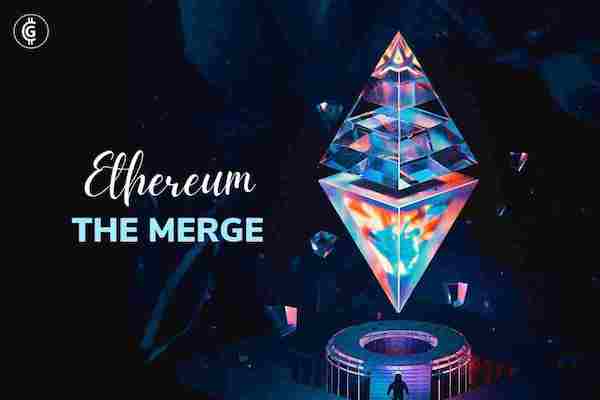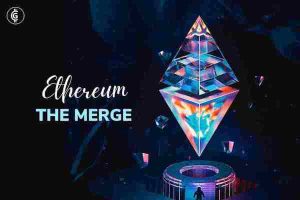Join Our Telegram channel to stay up to date on breaking news coverage
After years of development and delay, the enormous Ethereum redesign known as the Merge has finally taken place, transferring the digital machinery at the center of the second-largest cryptocurrency to a system that uses a great deal less energy.
It was no easy task to switch from proof-of-work to proof-of-stake, two different ways to operate a blockchain. According to Justin Drake, a researcher at the charitable Ethereum Foundation, “The metaphor that I use is this idea of switching out an engine from a running car.” I like to compare it to the transition from gasoline to electricity.
The potential reward is enormous. Now, Ethereum should use 99.9% less energy. From the standpoint of energy costs, one assessment compares it to Finland abruptly shutting off its power grid.
The network, which supports a $60 billion ecosystem of cryptocurrency exchanges, lending organizations, non-fungible token (NFT) marketplaces, and other apps, will become more secure and scalable, according to Ethereum’s developers.
The assumption that Ethereum, the second-largest cryptocurrency after bitcoin (BTC), would eventually make this changeover was present from the beginning. The current market value of its ether (ETH) token is close to $200 billion. However, the transition required a difficult technological effort, one that was so dangerous that many questioned whether it would even succeed. Drake admitted, “There’s a part of me which hasn’t completely realized that this is actually happening.” and added “I’m somewhat in denial, you know, because I’ve trained myself to just expect it to happen in the future.”
Over 41,000 individuals were watching a “Ethereum Mainnet Merge Viewing Party” on YouTube when the Merge began in earnest at 2:43 AM EST. The operators of Ethereum’s new proof-of-stake network, known as validators, were observed with bated breath as important metrics poured in, signaling that they were acting as expected and adding new transactions to the blockchain’s ledger. The Merge “finalized” after roughly 15 arduous minutes, at which point it could be formally hailed a success.
Crypto investors, enthusiasts, and skeptics have been eagerly watching the update, which reduces the network’s dependency on the resource-intensive process of cryptocurrency mining, for the effects it is anticipated to have on the larger blockchain sector.
The Dallas Mavericks owner and investor Mark Cuban said he would be “watching [the Merge] with curiosity like everyone else,” pointing out that it would cause ETH to deflate.
ETH was trading at $1,594 soon after the Merge, down around 0.81% over the previous 24 hours.
The fact that the update may have been one of the biggest open-source software projects in history and required collaboration between dozens of teams and hundreds of individual academics, developers, and volunteers added to its complexity.
“I think the Merge can genuinely get those people who were interested in Ethereum, but skeptical of the environmental impacts, to come and experiment with it” said Tim Beiko, an Ethereum Foundation developer who played a significant role in organizing the update.
Farewell, miners
A decentralized ledger, or a single, unchangeable record of transactions that computers around the world may read, edit, and trust without the need for middlemen, was first proposed by Bitcoin in 2008. With smart contracts, or computer programs that effectively exploit the blockchain as a global supercomputer, recording data onto its network, Ethereum, announced in 2015, built upon the fundamental ideas of Bitcoin. Decentralized financing (DeFi) and NFTs, the key drivers of the most recent crypto bubble, were made possible by this breakthrough.
As a result of The Merge, Ethereum’s proof-of-work system, which included crypto miners competing to add transactions to its ledger and earning incentives for doing so by cracking codes, is no longer in use.
The majority of cryptocurrency mining currently takes place in “farms,” but factories might be a better description. Imagine huge warehouses filled with rows of computers stacked on top of one another like bookcases in a university library, each one scorching to the touch from the strain of producing cryptocurrency.
This method, which was invented by Bitcoin, is what made Ethereum consume so much energy and is to blame for the blockchain industry’s image as a threat to the environment.
Ben Edgington, a product leader at the Ethereum research and development company ConsenSys, said, “My daughter and I discussed NFTs a few months ago.” When I very carelessly brought up some NFT initiatives at the dinner table, she yelled at me, “How can you boil the oceans with this nonsense? This is terrible. I find it hard to believe you do this for a living.
Edgington, who started his career studying climate science before transitioning to the crypto industry, recognized his daughter’s perspective. She had undoubtedly ingested a highly poisonous environmental story, he claimed. It’s difficult to defend “stickers for adults” that, according to some calculations, produce a megaton of [carbon dioxide] each week.
Welcome, stakers
The new proof-of-stake Ethereum protocol completely eliminates mining. Validators, who “stake” at least 32 ETH to an address on the Ethereum network where they can neither be bought nor sold, take the place of miners. Similar to lottery tickets, these staked ETH tokens: A validator’s chances of having one of its tickets picked and being able to add a “block” of transactions to Ethereum’s digital ledger increase with the amount of ETH they bet.
The Beacon Chain, a proof-of-stake network that Ethereum launched in 2020, served only as a staging location for validators to prepare for the switch up until the Merge. The Beacon Chain and the Ethereum main network were combined in order for Ethereum to switch to proof-of-stake.
In terms of its influence on the environment, Beiko claims that proof-of-energy stake’s use “is not even a rounding error.”
According to him, “Proof-of-stake is like running an app on your MacBook.” It’s similar to using Slack. It’s similar to using Netflix or Google Chrome. Of course, your MacBook requires electricity to function and is plugged into the wall. But nobody considers Slack’s influence on the environment, right?
The advantage of the Merge upgrade that excites Edgington the most personally is its effect on the environment, he said. “I feel incredibly proud to be able to look back and say I helped remove a megaton of carbon dioxide from the environment every week, you know. My family and other people are significantly impacted by that, he said.
Better incentives
The Ethereum network is better understood as a nation-state than as a single piece of open-source software; it is a kind of living organism that forms when a number of computers communicate with one another in a common language and all adhere to the same set of laws.
With the help of Ethereum’s new architecture, these computers will have new incentives to operate in accordance with the rules, protecting the ledger from unauthorized manipulation. “Proof-of-work is a mechanism by which you take physical resources and you convert them into security for the network. If you want your network to be more secure, you need more of those physical resources”, according to Beiko. In terms of proof-of-stake, we convert money resources into security.
Even while Ethereum’s proof-of-work network was being operated and secured by thousands of individual miners, machines from just three mining pools controlled the majority of the network’s hashrate, a metric for the total processing power of all miners.
A so-called 51% attack would have been conceivable if a handful of Ethereum’s biggest mining companies banded together to gather a majority of the network’s hashrate, making it difficult or impossible for anyone else to update the ledger.
In proof-of-stake, power over the network is determined by the amount of ETH one stakes, not by the amount of energy one uses. Supporters of proof-of-stake argue that this makes attacks more expensive and futile because attackers risk having their staked ETH decreased in retaliation for trying to disrupt the network. Not everyone believes the buzz around proof-of-stake. There are no indications that proof-of-work, the more tried-and-true and secure approach, will ever be dropped from Bitcoin, for example.
Even while a small number of publicly traded mining syndicates will no longer hold a disproportionate amount of power over the Ethereum network, detractors contend that the existing power players will simply be replaced by new ones. On Ethereum’s proof-of-stake chain, Lido, a sort of community-run validator collective, has more than 30% of the stake. Another 30% of the network’s ownership is held by three of the biggest cryptocurrency exchanges: Coinbase, Kraken, and Binance.
Chandler Guo, a well-known cryptocurrency miner, said in the run-up to the Merge that he would build a fork of Ethereum’s old proof-of-work chain, a copy of Ethereum’s blockchain that continues to function using the previous miner-based system, in response to skepticism over proof-of-stake.
Proof-of-work forks have typically been mocked by Ethereum’s core developers as sideshows and frauds, but Guo’s “ETHPOW” effort and others like it have made some headway in some crypto communities.
Traders on the Merge
Since at least mid-July, traders have been speculating on the Merge in the cryptocurrency markets. At first, they thought the event would spur a sharp increase in the price of ETH. Following the meltdown in the markets for digital assets earlier in the year, the market for ETH options began pricing on post-Merge gains.
A new wave of activity was sparked by the possibility that enraged cryptocurrency miners would fork the Ethereum blockchain, this time as traders rushed to lock in value from the hypothetical airdrop of a new “ETHPOW” token.
The markets’ response to a successful Merge is generally impossible to forecast with accuracy. Since the upgrade has been planned for Ethereum since its start, it’s possible that the market has already included it into prices. Kevin Zhou of Galois Capital said, “I think if you asked me maybe around three weeks ago, I would argue that not only is it priced in, it’s overpriced.” Currently, there is an approximately 70/30 market split in favor of this being a good development for ETH.
What’s in store next?
The co-creator of Ethereum, Vitalik Buterin, commented on the Merge on a live webcast and said, “This is the first step towards Ethereum being a highly mature system, but there are further steps to go. The update did not address Ethereum’s relatively high fees and poor speeds, which continue to be a barrier to its user base expansion much as environmental concerns once were.
Sharding is one of the next stages Buterin has described for the network. This technique could help improve the network’s slow transaction speeds and high fees by distributing transactions over “shards,” similar to adding lanes to a freeway.
That upgrade was originally planned to coincide with the switch to proof-of-stake, but it was given lower priority as a result of the success rollups, a type of third-party solution, have had in addressing some of the same problems. Rollups hint at the likely direction of Ethereum development, where community solutions, as opposed to updates to the chain’s core code, will be key to enhancing the chain’s functionality.
Even if Ethereum’s environmental problems may be behind it now, the network still faces several challenges if it wants to expand its user base. But for now, it’s difficult to think that Ethereum’s engineers won’t be taking a few days off to celebrate after years of labor and megatons of carbon emissions.
Related
- Ethereum hardfork will be launched within 24 hours after the Merge
- Ethereum Merge Will Attract Institutions and Create Staking Boom
- Ethereum Price Prediction: The Merge To Include Crypto Deflation Benefits
Join Our Telegram channel to stay up to date on breaking news coverage


